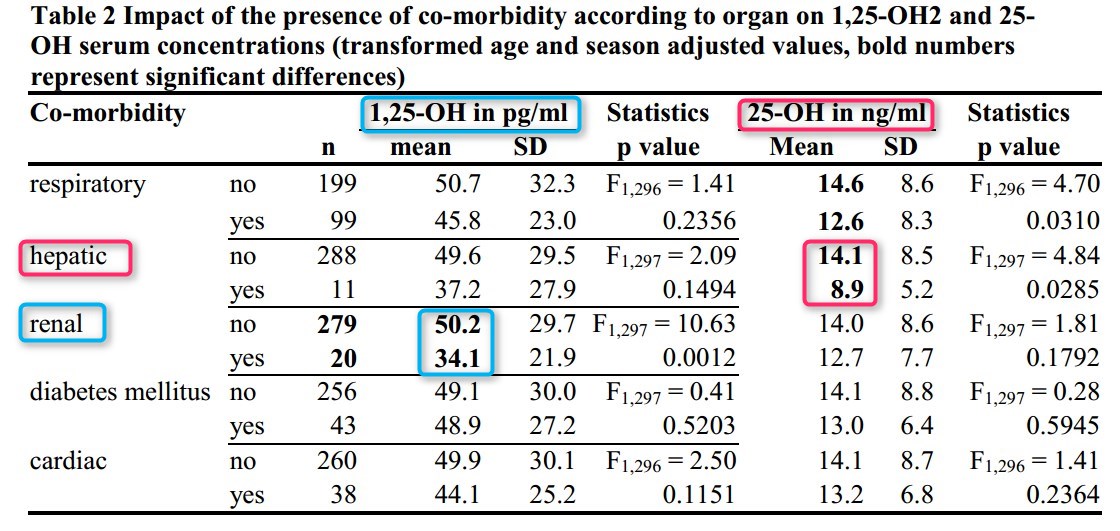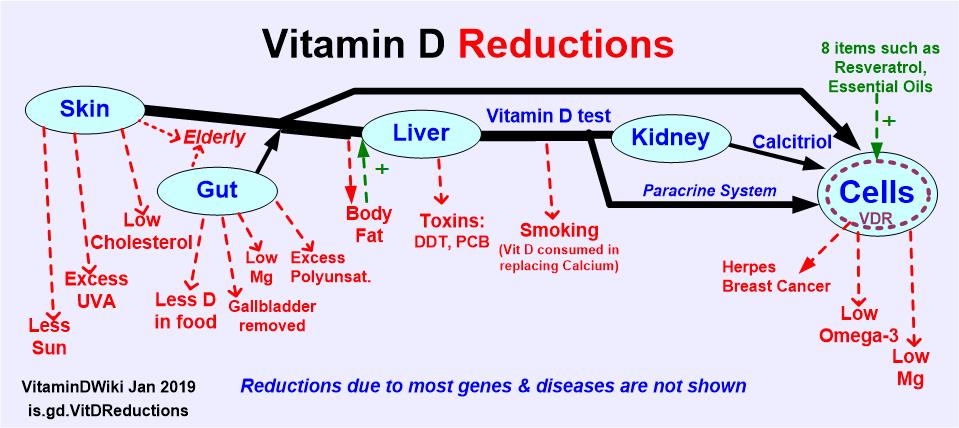Less Pneumonia in those having more activated vitamin D (kidneys working)
Vitamin D deficiency in community-acquired pneumonia: low levels of 1,25(OH)2 D are associated with disease severity
Respiratory Research 2014, 15:53 doi:10.1186/1465-9921-15-53
Mathias W Pletz, Christoph Terkamp, Ulrike Schumacher, Gernot Rohde, Hartwig Schütte, Tobias Welte and Robert Bals
Objectives
We aimed to explore the association between vitamin D levels and the severity, mortality and microbiological etiology of community-acquired pneumonia.
Methods
Vitamin D levels (both, the reservoir form 25-OH and the activated form 1,25-OH2) of 300 randomly selected patients with community-acquired pneumonia due to pre-specified pathogens included in the German competence network (CAPNETZ) study were measured. Prior to statistical analysis, values of 25-OH and 1,25-OH2 were power-transformed to achieve parametric distribution. All further analyses were performed with seasonally and age adjusted values.
Results
There was only a modest (Spearman Coefficient 0.38) positive correlation between 25-OH and 1,25-OH2. For 1,25-OH2 but not 25-OH, the general linear model revealed a significant inverse correlation between serum concentration and CURB score (p = 0.011). Liver and respiratory co-morbidity were associated with significantly lower 25-OH values and renal co-morbidity with significantly lower 1,25-OH2 values. No significant differences of 1,25-OH2 or 25-OH between different pathogens (influenza virus, Legionella spp., Streptococcus pneumoniae) were detected.
Conclusion
For 1,25-OH2, we found a significant and independent (controlled for age, season and pathogen) negative correlation to pneumonia severity. Therefore, supplementation of non-activated vitamin D to protect from pneumonia may be non-sufficient in patients that have a decreased capacity to hydroxylate 25-OH to 1,25-OH2.
From the PDF- which is attached at the bottom of this page
- “After seasonal adjustment, age had a significant impact on 1,25-OH2 levels (F1,297= 6.06, p = 0.0144) but not on 25-OH levels (F1,297= 0.03, p = 0.8588).”
- Vitamin D Life interpretation: Seniors have kidney problems, thus reducing the activation of vitamin D
Wide variance in the association between activated and typically measure serum level of vitamin D
As much as 50% variation in activated levels between individuals with the same serum level

Interesting: Liver problems reduced serum level, and somewhat reduced the activated level
Kidney problems did, as expected, reduce the activated level without reducing the serum level much

Interesting differences in vitamin D types vs types of Influenza
||Influenza type| 25-OH| 1,25-OH2
Influenza A|11 ng|64
Influenza B|13 ng|31||
Vitamin D Life speculation: Influenza B degrades the Kidney function.
See also Vitamin D Life
Search Vitamin D Life for INFLUENZA 2150 hits as of April 2014
Search Vitamin D Life for pneumonia 508 hits as of June 2017
Pneumonia in seniors was 2.5X more likely if low vitamin D – June 2014
What blocks vitamin D from getting to cells - in addition to genes and diseases has the following chart

Overview Kidney and vitamin D contains the following summary
{include}
